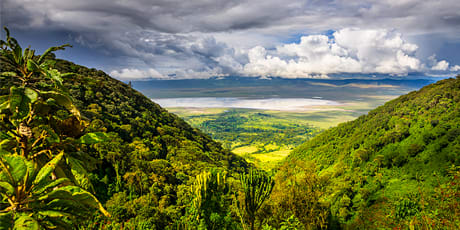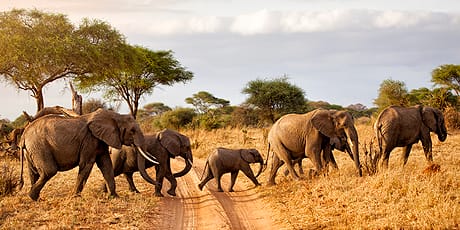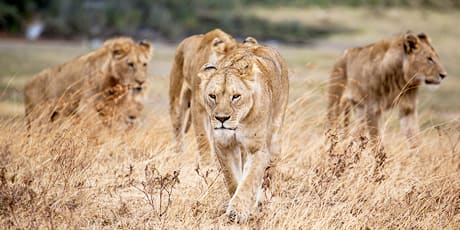 Tanzania
Tanzania
"God's thumbprint," a crater lined with lush grassland where lions recline feet from elephants, symbolizes this land of mythical proportions. Acacia trees dot a vast horizon, and flamingos cast a pink mirage on Lake Manyara National Park. The Masai Mara's traditional welcome transports you to another world of drumbeats, chants, and dance. Travel to Tanzania for the adventure of a lifetime!
Highlights
- Ngorongoro Crater
Located in the Ngorongoro Conservation Area, this giant crater resulted from an enormous volcanic explosion and collapsed 2-3 million years ago. The Ngorongoro Crater was declared a UNESCO World Heritage site in 1978, and today stands as the largest intact volcanic crater in the world! Named one of the Seven Natural Wonders in Africa, this fertile valley is home to an abundance of wildlife (over 25,000 animals!), such as buffalo, elephants, leopards, rhinos, zebras, cheetahs, and the densest known population of lions. However, one animal you won't find in the crater is giraffes since the crater's sides are too steep for them to journey down. Measuring about 10 miles wide and 2,000 ft. deep, the Ngorongoro Crater is one of the most important prehistoric sites in the world, where fossil evidence of the earliest known human species was discovered!
- Tarangire National Park
Tarangire National Park is Tanzania's sixth-largest national park. Its name originated from the Tarangire River that flows across the area, providing wildlife their primary source of fresh water (especially during the dry season when they would migrate from Manyara National Park). In the park, you can find lush swamps that are home to about 550 variations of birds, more species in one habitat than anywhere else in the world! Many elephants are found roaming the grounds and quenching their thirst on the bark of the iconic baobab trees that dot the region. Above, pythons, lions, and leopards lounge in the branches of the trees, observing life continuing below them.
- Great Rift Valley
Made up of a series of geographic trenches, the Great Rift Valley stretches over 3,500 miles from Lebanon in Asia to Mozambique in Africa. This world's natural wonder is highly active, featuring numerous volcanoes, hot springs, geysers, and earthquakes. In Africa, the valley is divided into the Western Rift Valley and the Eastern Rift Valley. While the Western Rift Valley is lined with towering mountains and sprawling lakes, the Eastern Rift Valley is bordered by Mount Kilimanjaro, Ngorongoro Crater, Empakaai Crater, Olmoti Crater, and Ol Doinyo Lengai volcano in Tanzania.
- The "Big 5"
The term "Big 5" refers to the large mammals popularly seen on African safaris: lions, leopards, rhinoceros, elephants, and Cape buffalo. Big game hunters initially used this term to describe the collection of animals that are the most difficult to hunt by foot in Africa. Now, safari tours use the term widely to describe the incredible group of wildlife that game seekers may see. So keep your eyes peeled for these fantastic creatures, whether looking in the trees for a sleeping leopard or following the sounds of enormous thumping to see massive elephants.
- Mt. Kilimanjaro
High above the African plains stands the almost 20,000 ft. high Mount Kilimanjaro. The highest mountain in Africa and the largest free-standing mountain in the world is a dormant volcano with three volcanic cones: Kibo, Shira, and Mawenzi. Although Shira and Mawenzi are extinct volcanoes, Kibo is dormant. The last major eruption of this volcano was over 350,000 years ago, with the most recent activity occurring about 200 years ago. This magnificent mountain was first climbed back in 1889. Today, almost 30,000 people climb Mount Kilimanjaro every year, with about 2/3 of those climbers successfully making it to the top.
Fast Facts
Already booked on one of our packages to Tanzania? See everything you need to know before you go.
| Overview | Capital: Dodoma |
| Entry requirements | Please see our Entry Requirements page. |
| Staying Healthy | Malaria Malaria is present in Tanzania. Take precautions against getting mosquito bites. Speak with your doctor about taking a prescription medicine (before, during, and after your trip) to prevent malaria. CDC Malaria guidance: Tanzania Yellow Fever The CDC does not recommend yellow fever vaccine for most travelers to Tanzania. CDC Guidance by country: Tanzania Proof of Yellow Fever Vaccination is required for travelers arriving to Tanzania from a country with risk of Yellow Fever transmission. This includes airport transits or layovers of more than 12 hours in countries with a Yellow Fever risk. World Health Organization, List of Yellow Fever Endemic Countries Do not swim in freshwater streams, lakes or rivers as they are full of parasites. Disinfect and cover all wounds to prevent infection. |
| Weather | Tanzania does not have large seasonal variations since it is so close to the equator. The weather is best June thru September, although most animals have migrated to Kenya at that time. September thru March is also a good time to visit. Rainy season occurs April and May. Mount Kilimanjaro is very, very cold at its higher elevations. |
| What to wear | We suggest bringing clothes made of cotton, preferably in neutral colors (especially for game drives). A hat, scarf, sunscreen and insect repellent are also valuable accessories for your trip. If you have two pairs of comfortable (broken in, not brand new) walking shoes, by all means, take both pairs. Since weather can be unpredictable anywhere in the world and to be sure you are comfortable during your trip and prepared for all types of weather possibilities, we recommend that you carry a small folding umbrella (or poncho) and take with you a light jacket or sweater. Packing to dress in layers is another way to prepare for a variety of weather conditions. Finally, remember that the countries visited on this tour are casual, and comfort should dictate your wardrobe for the tour. Binoculars are also suggested. |
| Tipping | A small gratuity to your guides and drivers will be greatly appreciated by them. The recommended amount is $12-15 per person per day for your Safari driver/guide. A $1 gratuity to restaurant staff per meal (lunch/dinner), $1 to hotels/lodges porters per bag upon arrival and departure and $2-3 to transfer drivers per transfer is also appreciated. A $5-10 per person to Balloon safari pilot if taking the optional Hot Air Balloon Safari tour. For parents travelling with children, 50% of the suggested tipping rates are recommended on behalf of their children. As always, gratuities are an individual expression of thanks and should be based on the level of service provided. |
| Money & Credit Cards | Credit cards are the most convenient way to pay for items you purchase as you travel. Be sure to call your credit card providers to let them know you will be traveling abroad, the places you’ll be visiting and the dates of your trip. This is important for your own protection. For small purchases, we recommend that you use the ATM machines to get cash in local currency so that you can avoid using your credit card in unknown shops where there is a higher risk of having your credit card numbers “borrowed” for unauthorized purchases. We suggest that you bring along cash in small denominations and we highly recommended that you bring crisp, new bills. If you wish to exchange U.S. dollars to the local currency, new, crisp U.S. dollar in large bills ($20, $50, $100) are preferred. Old, torn, crumpled bills & US dollars printed 2012 or earlier are not accepted in East Africa. Always notify your bank prior to departure to avoid any problems using your credit or debit card while traveling. |
| Shopping | The best items to shop for in Tanzania are local handcrafts including pottery, Makonde carpets, sculptures, paintings, soapstone carvings, fabric, cloth paintings of Kilimanjaro, chests, and gems. Prices are not usually marked and bargaining is expected. |
| Electricity & Power Adapters | 230 volts. Plugs D & G. You will need a voltage converter, and plug adapter in order to use U.S. appliances. We recommend getting a universal adapter and converter kit. Learn more about electrical standards around the world. |
| Cell Phones & Internet | Want to take your cell phone, tablet or laptop, but not sure how to get cell service or wifi? Read up on using your cell phone abroad and the top 5 ways to get Internet abroad. |
| Photography | Cameras and video recorders are permitted, and photography is generally permitted everywhere except at airports and military installations. Memory cards for digital cameras will be available in major cities. |
| Did you know? |
|
Frequently Asked Questions
- I heard Tanzania has banned plastic bags?
[May 2019] In an effort to curb litter and support environmental sustainability, Tanzania's ban on plastic bags will go into effect June 1, 2019. All plastic carrier bags, regardless of their thickness, will be prohibited from being imported, exported, manufactured, sold, stored, supplied and used in the country.
Special desks will be designated at all entry points to the country where any plastic carrier bags brought into Tanzania can be surrendered. (You will not be fined as long as you comply.) The Ziploc® bags used to carry liquids through security are exempt from this ban.
Tours & Packages
- Destinations: Tanzania
- including closed packages
Trip Reviews & Photos
We love hearing your stories and seeing your photos! Check out our entire fan photo gallery and upload your photos.

 Located in the Ngorongoro Conservation Area, this giant crater resulted from an enormous volcanic explosion and collapsed 2-3 million years ago. The Ngorongoro Crater was declared a UNESCO World Heritage site in 1978, and today stands as the largest intact volcanic crater in the world! Named one of the Seven Natural Wonders in Africa, this fertile valley is home to an abundance of wildlife (over 25,000 animals!), such as buffalo, elephants, leopards, rhinos, zebras, cheetahs, and the densest known population of lions. However, one animal you won't find in the crater is giraffes since the crater's sides are too steep for them to journey down. Measuring about 10 miles wide and 2,000 ft. deep, the Ngorongoro Crater is one of the most important prehistoric sites in the world, where fossil evidence of the earliest known human species was discovered!
Located in the Ngorongoro Conservation Area, this giant crater resulted from an enormous volcanic explosion and collapsed 2-3 million years ago. The Ngorongoro Crater was declared a UNESCO World Heritage site in 1978, and today stands as the largest intact volcanic crater in the world! Named one of the Seven Natural Wonders in Africa, this fertile valley is home to an abundance of wildlife (over 25,000 animals!), such as buffalo, elephants, leopards, rhinos, zebras, cheetahs, and the densest known population of lions. However, one animal you won't find in the crater is giraffes since the crater's sides are too steep for them to journey down. Measuring about 10 miles wide and 2,000 ft. deep, the Ngorongoro Crater is one of the most important prehistoric sites in the world, where fossil evidence of the earliest known human species was discovered! Tarangire National Park is Tanzania's sixth-largest national park. Its name originated from the Tarangire River that flows across the area, providing wildlife their primary source of fresh water (especially during the dry season when they would migrate from Manyara National Park). In the park, you can find lush swamps that are home to about 550 variations of birds, more species in one habitat than anywhere else in the world! Many elephants are found roaming the grounds and quenching their thirst on the bark of the iconic baobab trees that dot the region. Above, pythons, lions, and leopards lounge in the branches of the trees, observing life continuing below them.
Tarangire National Park is Tanzania's sixth-largest national park. Its name originated from the Tarangire River that flows across the area, providing wildlife their primary source of fresh water (especially during the dry season when they would migrate from Manyara National Park). In the park, you can find lush swamps that are home to about 550 variations of birds, more species in one habitat than anywhere else in the world! Many elephants are found roaming the grounds and quenching their thirst on the bark of the iconic baobab trees that dot the region. Above, pythons, lions, and leopards lounge in the branches of the trees, observing life continuing below them. Made up of a series of geographic trenches, the Great Rift Valley stretches over 3,500 miles from Lebanon in Asia to Mozambique in Africa. This world's natural wonder is highly active, featuring numerous volcanoes, hot springs, geysers, and earthquakes. In Africa, the valley is divided into the Western Rift Valley and the Eastern Rift Valley. While the Western Rift Valley is lined with towering mountains and sprawling lakes, the Eastern Rift Valley is bordered by Mount Kilimanjaro, Ngorongoro Crater, Empakaai Crater, Olmoti Crater, and Ol Doinyo Lengai volcano in Tanzania.
Made up of a series of geographic trenches, the Great Rift Valley stretches over 3,500 miles from Lebanon in Asia to Mozambique in Africa. This world's natural wonder is highly active, featuring numerous volcanoes, hot springs, geysers, and earthquakes. In Africa, the valley is divided into the Western Rift Valley and the Eastern Rift Valley. While the Western Rift Valley is lined with towering mountains and sprawling lakes, the Eastern Rift Valley is bordered by Mount Kilimanjaro, Ngorongoro Crater, Empakaai Crater, Olmoti Crater, and Ol Doinyo Lengai volcano in Tanzania.  The term "Big 5" refers to the large mammals popularly seen on African safaris: lions, leopards, rhinoceros, elephants, and Cape buffalo. Big game hunters initially used this term to describe the collection of animals that are the most difficult to hunt by foot in Africa. Now, safari tours use the term widely to describe the incredible group of wildlife that game seekers may see. So keep your eyes peeled for these fantastic creatures, whether looking in the trees for a sleeping leopard or following the sounds of enormous thumping to see massive elephants.
The term "Big 5" refers to the large mammals popularly seen on African safaris: lions, leopards, rhinoceros, elephants, and Cape buffalo. Big game hunters initially used this term to describe the collection of animals that are the most difficult to hunt by foot in Africa. Now, safari tours use the term widely to describe the incredible group of wildlife that game seekers may see. So keep your eyes peeled for these fantastic creatures, whether looking in the trees for a sleeping leopard or following the sounds of enormous thumping to see massive elephants.  High above the African plains stands the almost 20,000 ft. high Mount Kilimanjaro. The highest mountain in Africa and the largest free-standing mountain in the world is a dormant volcano with three volcanic cones: Kibo, Shira, and Mawenzi. Although Shira and Mawenzi are extinct volcanoes, Kibo is dormant. The last major eruption of this volcano was over 350,000 years ago, with the most recent activity occurring about 200 years ago. This magnificent mountain was first climbed back in 1889. Today, almost 30,000 people climb Mount Kilimanjaro every year, with about 2/3 of those climbers successfully making it to the top.
High above the African plains stands the almost 20,000 ft. high Mount Kilimanjaro. The highest mountain in Africa and the largest free-standing mountain in the world is a dormant volcano with three volcanic cones: Kibo, Shira, and Mawenzi. Although Shira and Mawenzi are extinct volcanoes, Kibo is dormant. The last major eruption of this volcano was over 350,000 years ago, with the most recent activity occurring about 200 years ago. This magnificent mountain was first climbed back in 1889. Today, almost 30,000 people climb Mount Kilimanjaro every year, with about 2/3 of those climbers successfully making it to the top.